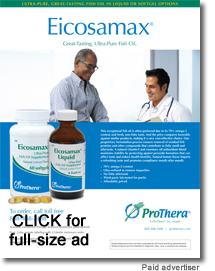|
Page 1, 2
Cardiovascular health and renal health go hand in hand with considerable overlap of confounding conditions including advancing age, hypertension, obesity, and uncontrolled blood sugar. It has long been recognized that the number one cause of mortality in renal patients is not renal failure but secondary heart disease.1 Among patients with CHF estimates of renal disease vary from 30 to 50 % depending on the markers used and specific population studied.2 Worsening renal function is a prognostic indicator in cardiac patients, as increasing serum creatinine is associated with an increased risk of death and cardiac failure.3
 The comorbidities of cardiovascular disease and renal disease are often exacerbated by anemia. This downward spiral and the interactions of these conditions has been termed cardio-renal anemia syndrome.2 As this situation progresses, patients often become more and more dependent on multiple pharmaceuticals; but targeted dietary changes and supplementation may improve blood markers of function and reduce the need for prescription drugs. Many botanical medicines and nutraceuticals used for renal disease may help cardiovascular health and vice versa. The comorbidities of cardiovascular disease and renal disease are often exacerbated by anemia. This downward spiral and the interactions of these conditions has been termed cardio-renal anemia syndrome.2 As this situation progresses, patients often become more and more dependent on multiple pharmaceuticals; but targeted dietary changes and supplementation may improve blood markers of function and reduce the need for prescription drugs. Many botanical medicines and nutraceuticals used for renal disease may help cardiovascular health and vice versa.
With renal disease, the mechanism for anemia is clearly understood as it is often due to reduced production of erythropoietin. However, with nephrotic syndrome, urinary loss of erythropoietin along with a loss of iron and transferrin contribute to anemia.4 Activation of the renin-angiotensin-aldosterone system (RAAS) and antidiuretic hormone cause renal vasoconstriction and reduced perfusion of the kidneys. Additionally, salt and water retention cause hemodilution. Tissue hypoxia from anemia causes peripheral dilation, which reduces blood pressure. This reduction in blood pressure activates RAAS and increases the sympathetic nervous system response, causing tachycardia to maintain adequate blood pressure. Activated sympathetic response then leads to more renal vasoconstriction. All of these factors can lead to a reduced perfusion of the kidneys, which in turn leads to reduced erythropoietin production and further anemia. Thus, the renal patient is often caught in a downward spiral if there is no intervention.2
With cardiac patients, the cause of anemia can also be multifactorial. Hemodilution due to right-sided heart failure, although not true anemia, is associated with adverse outcomes. Heart failure creates a state of persistent inflammation. High levels of cytokines, including tumor necrosis factor (TNF)-α and Il-6, inhibit production of erythropoietin as well as the bone marrow response to erythropoietin, reducing hematogenesis and creating the anemia of chronic disease.5 Inflammation may inhibit the uptake of iron in the gut, however, even with adequate iron levels, inflammation may inhibit its utilization. The patient may have low hemoglobin but very high ferritin.6
Some of the interventions used on cardiac and renal patients may also contribute to anemia. Aspirin can contribute to anemia through blood loss in the gut. ACE inhibitors may have fewer side effects than other anti-hypertensive agents, but have been shown to decrease renal secretion of erythropoietin.7 Also commonly used for these patients, proton pump inhibitors may contribute to anemia through decreased B12 absorption.
Synthetic erythropoietin injections (EPO) are often made available to patients if anemia is severe enough. In practice, however, insurance approval may be slow for this very expensive medication and out-of-pocket cost may be prohibitive. Many patients the author sees in practice also hesitate to take EPO shots after becoming aware of the side effect of increased blood clots. Although a lack of red blood cells does mean fewer chances to form blood clots, the deleterious effects of uncorrected anemia generally have far worse consequences.
There are natural agents that have the potential to increase hematocrit, which could reduce the size and frequency of prescription shots. This can also be important for some patients who are unresponsive to the shots. L-carnitine, which often runs low with advanced kidney disease, can improve hematocrit levels in patients who are poor EPO responders.8 Also the herb Angelica sinensis (Dong quai) can stimulate hematogenesis.9 It appears to work even better when used in combination with Astragalus membranaceus.10
Nutritional deficiencies can also play a role in the development of anemia for these patients. Increasing uremia is notorious for causing a lack of appetite. A lack of appetite may also be a problem among the elderly patients. Other patients are unsure of what to eat. They know the standard American diet is not working for them but need guidance on how to adopt alternatives. Also, as many renal patients opt for a vegetarian diet to decrease the stress on the kidneys, they may be lacking in B12 and iron. Dialysis patients in particular may be lacking in B-vitamins as water-soluble vitamins are washed out during their treatment. This situation could be exacerbated if poor methylation is an issue for the patient.
Chronic kidney disease patients may be supplementing with iron, and dialysis patients are often given a course of iron injections as part of their treatment. However, this intensive dose of iron may be excessive, and ferritin should be monitored. Iron overload may lead to increased oxidative stress for the heart and contribute to atherosclerosis. While correcting anemia, practitioners should be aware that a high level of iron can also increase susceptibility to infection, which may increase morbidity and mortality. Iron may not only lead to increased microbial growth but can suppress CD4+ T cells and antibody production. During acute infections, iron supplementation should be at least temporarily withheld.11
Besides iron, another mineral that must be closely monitored is potassium. Elevated potassium is the most immediate threat to a patient with advanced renal disease and may directly impact cardiac health. As the creatinine becomes elevated, the kidneys lose the ability to expel potassium in the urine. Hyperkalemia can cause a deadly arrhythmia in patients with marginal kidney function. Common medications that can drive up potassium include ACE inhibitors, potassium-sparing diuretics, and beta blockers.12
Normally beneficial supplements may become problematic in patients prone toward hyperkalemia. Among the herbs highest in potassium are parsley, hops, catnip, asparagus root, and bupleurum.13 Unfortunately, many nutrient-dense foods are very high in potassium, and the dietary guidelines given to these patients often advise many processed foods with low nutritional value. However, it is still possible to eat a whole foods diet and still maintain a low potassium intake. Cauliflower, string beans, and zucchini would be better choices than broccoli or leafy greens. Low potassium fruits include apples, berries, plums, and grapes.14 The potassium limited diet should only be initiated when necessary as the blood tests indicate that potassium is approaching an elevated range. In practice, it is observed that patients often initiate a low potassium diet prematurely with the intention of reducing stress on the kidneys. This, however, is not helpful as hypokalemia may also be problematic.
In addition to iron and potassium, phosphorus is problematic for renal patients. Although phosphorus is a less immediate threat than elevated potassium, elevated phosphorus can wreak havoc on the renal patient over time. Phosphorus that should be excreted in the urine becomes elevated in the blood stream. High phosphorus causes an elevation of parathyroid hormone, releasing calcium from the bones. Not only does this cause osteomalacia, but calcium binds to phosphorus deposits in soft tissue. Calcification of the blood vessels and the heart valves is yet another stressor on the cardiovascular system for the renal patient.15
Managing phosphorus is an ongoing struggle for patients with advanced renal disease. Some dietary phosphorus is easily avoided by eliminating soft drinks with phosphoric acid and processed foods with phosphate-based preservatives. Patients should be made aware that fast foods, in particular, have a very high content of added phosphates. Phosphorus is also present in many dietary supplements such as phosphatidylserine, phosphatidylcholine, lecithin, or calcium in the form of calcium phosphate. While fish oil usually does not contain phosphorus, krill oil may be high in phosphorus. Other dietary sources of phosphorus cannot be completely eliminated as phosphorus will always accompany protein. Extended release niacin may be of some assistance, but for most patients with advanced renal disease, prescription phosphorus binders are usually a necessity.16 However, even with acceptable phosphorus control, PTH may remain elevated, creating a need for intervention to lower PTH.
Although adequate vitamin D is important, appropriate levels should be adjusted for renal patients. Vitamin D increases the uptake of both calcium and phosphorus. In order to avoid phosphorus overload, vitamin D should be maintained on the lower end of the normal range. The compound fibroblast growth factor-23 (FGF23) is produced in the osteocytes in response to high phosphorus. It acts as a hormone to reduce phosphorus reabsorption in the kidney and decrease renal production of 1,25(OH)2-D. This action of FGF23 comes at a price, however, and contributes to cardiomyocyte hypertrophy, vascular calcification, and endothelial dysfunction. High circulating phosphorus is the main force driving up FGF23, but anemia and iron deficiency can also lead to increased levels.17
Malignant hypertension is another cause of cardiac stress in renal patients. As the ability to filter uremic wastes declines, so does the ability to regulate blood pressure. As the patient approaches end stage renal disease (ESRD), natural interventions may be a helpful adjunct to blood pressure control; but multiple therapies are usually necessary, and it may be difficult to completely control blood pressure without pharmaceutical assistance. Practitioners should anticipate that when uncontrolled blood pressure becomes successfully managed with advanced renal disease, there is often a sudden increase in creatinine. This is not due to worsening damage to kidneys. As the filtration within the kidneys takes place across a pressure gradient, a lessening of internal pressure within the kidneys will decrease the glomerular filtration.18 A healthy kidney would be able to continue to filter with normalized blood pressure. Patients may attribute this shift in creatinine to toxicity of medications; however, the medications did not damage the kidney but simply revealed how much damage has already taken place.
Page 1, 2
|
![]()
![]()
![]()
![]()





